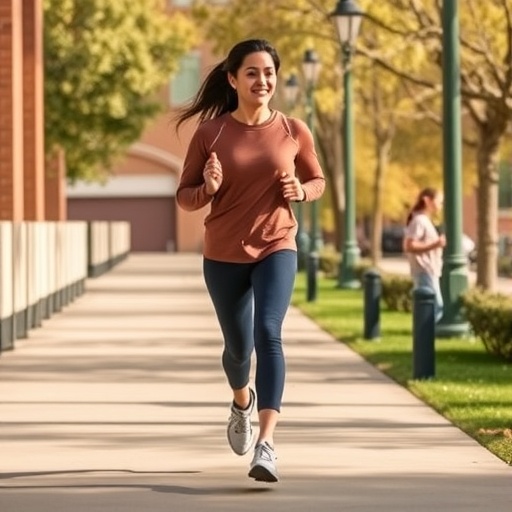In the midst of an era dominated by sedentary lifestyles and escalating mental health challenges, a groundbreaking study from The University of Texas at Arlington (UTA) sheds new light on the subtle yet profound impact of light physical activity on mood enhancement. Spearheaded by kinesiology Professor Yue Liao in collaboration with Monash University researchers, this study challenges the conventional paradigm that vigorous exercise alone is the key to mental well-being by demonstrating that even modest movement can substantially elevate mood and energy levels the subsequent day.
This extensive research monitored over 350 young adults, utilizing cutting-edge wearable activity monitors to precisely capture daily behavioral patterns encompassing sleep, sedentary periods, light activity, and moderate to vigorous exercise. By conducting a comprehensive 24-hour compositional data analysis using Bayesian multilevel modeling, the team was able to parse out nuanced associations between these behaviors and next-day affective states, a methodological choice notable for its sophistication and phase-integrative approach.
The crux of the findings revealed that replacing as little as 30 minutes of sitting time with light activity—activities as unassuming as household chores or casual walking—yielded significant improvements in mood and vitality the day following. Importantly, these benefits manifested without necessitating the strain of high-intensity workouts, a revelation that underscores the accessibility and scalability of such interventions for the broader population. The data underscore that the mood-enhancing effects are not merely a function of comparing oneself to others but stem from individualized within-person changes relative to one’s baseline behavior.
Underlying this work is a critical examination of current sedentary tendencies that pervade modern society. According to a related survey conducted in early 2024 by the smart seating company Kalogon, a staggering 38% of U.S. adults spend nine or more hours daily sitting, a behavior empirically linked to deleterious physical and psychological outcomes. This context heightens the public health relevance of identifying pragmatic strategies that can mitigate the impacts of prolonged inactivity without the barriers posed by gym access, structured exercise programs, or significant lifestyle upheavals.
Prior research has often spotlighted moderate to vigorous exercise as a panacea for mental health. While such activity confers undeniable benefits, this study positions light movement as an independent and perhaps more attainable lever for emotional regulation. The researchers documented that although moderate and vigorous exercise contributed to modest mood improvements, light activity exerted the most robust and consistent positive effect on next-day mood and energy levels. This challenges traditional exercise prescriptions by expanding the spectrum of beneficial behaviors to include less effort-intensive physical engagement.
The methodological strength of the study lies in its compositional framework, which recognizes that within any 24-hour cycle, the sum of sleep, sedentary behavior, light activity, and exercise must equate to a fixed total. This holistic perspective allows for an examination of trade-offs and substitution effects; for instance, how increasing light activity inherently necessitates reducing sedentary time, and how these shifts translate biologically and psychologically into affective outcomes. The Bayesian multilevel approach enabled nuanced inference that accounted for inter-individual variability and temporal dynamics, thereby enhancing the ecological validity of the conclusions.
Intriguingly, the study also explored sleep duration as a variable given its well-documented ties to mood. Contrary to some expectations, no clear direct effect of sleep length on next-day mood was observed within this young adult cohort, suggesting that in populations without clinical sleep disturbances, light physical activity might wield a more salient influence on daily emotional fluctuations than sleep duration alone. This insight warrants further exploration into the differential roles of sleep quality and quantity and their interaction with physical activity patterns.
Professor Liao emphasizes that the implications of this research transcend mere physical health—light movement acts as an immediate and accessible mood modulator, fostering a sense of increased energy and psychological resilience. The notion of “not having to work up a sweat” dismantles psychological barriers often associated with physical activity adoption, potentially democratizing the mental health benefits of movement across diverse demographic groups, including those less inclined or able to engage in strenuous exercise.
Within the broader societal framework, this study advocates for a paradigm shift towards integrating micro-movements into daily routines as a potent strategy against the epidemic of sedentary behavior and associated mood disorders. Subtle interventions such as incorporating brief bouts of standing, gentle ambulation during breaks, or performing light household tasks might provide scalable and cost-effective public health avenues to enhance psychological well-being at the population level.
The collaboration between UTA and Monash University encapsulates the increasingly interdisciplinary nature of health research, merging technological innovations in wearable devices with sophisticated statistical models and behavioral science to deliver actionable insights. This multidisciplinary approach ensures that findings not only advance academic understanding but also translate into pragmatic guidance for individuals and policymakers seeking to foster healthier lifestyles.
Projected against the backdrop of UTA’s status as a Carnegie R-1 research institution and its commitment to innovative and impactful scholarship, this study stands as a testament to the university’s role in pushing the frontiers of knowledge at the intersection of kinesiology, psychology, and public health. As society grapples with rising sedentary behavior and mental health burdens, such research is indispensable in charting new pathways toward well-being grounded in evidence and inclusivity.
In summary, Professor Yue Liao’s research overturns long-held assumptions by elucidating that simple, light physical activities interspersed throughout the day are not merely adjuncts but potent determinants of mood and energy enhancement. This discovery calls for broader adoption of everyday movement as a primary strategy for mental health promotion, signaling a promising step toward mitigating the psychological toll of modern sedentary lifestyles through accessible, sustainable behavior change.
Subject of Research: People
Article Title: Daily, prospective associations of sleep, physical activity, and sedentary behaviour with affect: A Bayesian multilevel compositional data analysis
News Publication Date: 19-Sep-2025
Web References: DOI 10.1016/j.psychsport.2025.102997
Image Credits: UT Arlington
Keywords: Human health, Physical exercise, Wearable devices, Sleep




